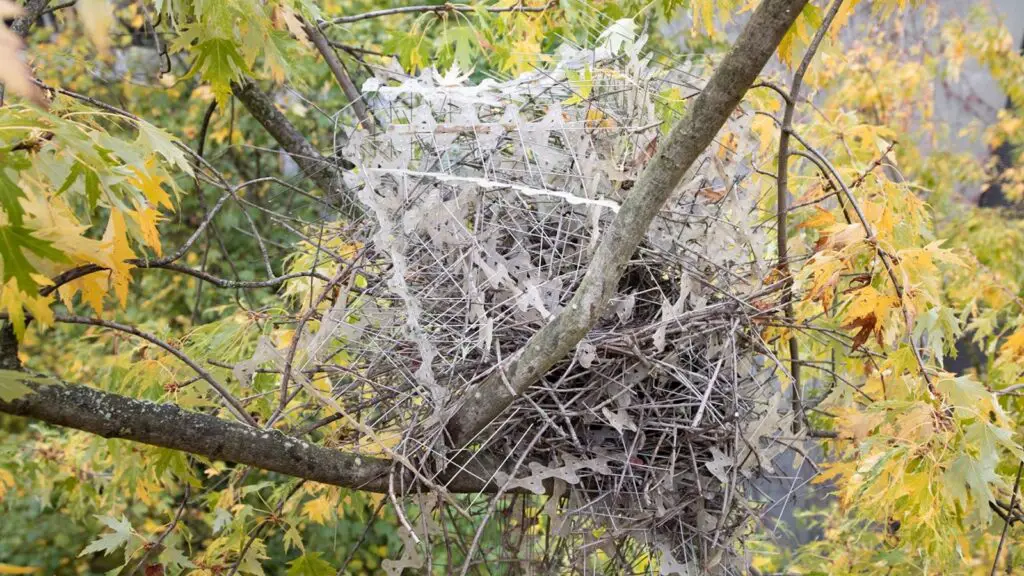Animals
Birds Are Stealing ‘Anti-Bird’ Spikes To Build Their Nests

In a fascinating show of avian resourcefulness, birds have been observed pilfering anti-bird spikes installed by humans, then using them in the construction of their nests.
The recent discovery illustrates the remarkable adaptability of birds, and in a surprising twist, they are using these deterrent tools designed to inhibit their nesting behavior to their own advantage.
Researchers from two eminent Dutch natural history institutions initially stumbled upon this intriguing phenomenon in an unexpected locale – the courtyard of a hospital in Antwerp. These institutions were the Naturalis Biodiversity Centre and the Natural History Museum in Rotterdam, both renowned for their extensive and exhaustive research in the realm of natural history.
Magpies, a species known for their intelligence and adaptability, had stripped approximately 50 meters of anti-bird spikes from the exterior of the hospital building. Astonishingly, these resourceful birds had used these purloined spikes to create an enormous nest consisting of about 1,500 individual spikes.
For those unfamiliar with anti-bird spikes, they are sets of pointed rods often affixed to buildings, primarily ledges, roofs, and balconies, to discourage birds from roosting or nesting there. The rationale behind their usage is to deter birds and thus minimize potential property damage and health risks associated with bird droppings.

Biologist Auke-Florian Hiemstra from the Naturalis Biodiversity Centre put forth a hypothesis on the magpies’ unique usage of the spikes. He suggested that the magpies were using the spikes in a manner similar to humans – essentially as a means to deter other birds from encroaching upon their nest.
Hiemstra amusingly observed, “It’s like a joke, really,” adding that these nests were the most extraordinary bird nests he had encountered in his extensive career as a nest researcher.
Traditionally, magpies, protective by nature, build roofs over their nests to safeguard their eggs and young ones. They frequently use thorny branches as part of their nest building repertoire. However, within the confines of the urban jungle, anti-bird spikes seem to offer an intriguing alternative to their conventional resources.
This unconventional behavior has been hailed by the researchers as the “ultimate adaptation to life in the city.” The research, subsequently published in Deinsea, the annual review of the Natural History Museum in Rotterdam, mentioned similar magpie nests identified in the Netherlands, Belgium, and Scotland.
Interestingly, it wasn’t just magpies. Crows in the Netherlands, another species known for their intelligence and adaptability, have also been discovered building nests with anti-bird spikes.
Despite these fascinating revelations, this isn’t the first instance of birds resorting to inhospitable or unanticipated items for nest construction. In their quest for survival and adaptation, birds have been known to use a variety of sharp materials, such as barbed wire and even knitting needles, to reinforce the roofs of their nests.
This research brings up critical considerations about the health of bird populations, particularly in urban environments. As cities expand, the traditional habitats of many bird species are increasingly encroached upon. Birds are showing resilience and resourcefulness in adapting to these changes, as shown by their unconventional use of anti-bird spikes and other materials.
However, it also underlines the need for more bird-friendly urban planning, taking into account the natural habits and requirements of local bird species. Understanding bird behavior and needs is essential to foster a harmonious coexistence between humans and our feathered friends in the shared urban landscape.
Typos, corrections and/or news tips? Email us at Contact@TheMindUnleashed.com
